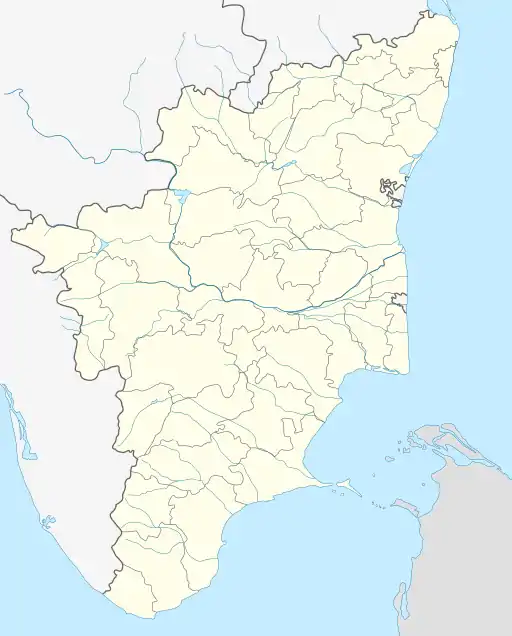Covelong
Kovalam (Covelong) is a fishing village in Chennai, India, 40 kilometres south of Chennai, on the East Coast Road en route to Mahabalipuram. Covelong was a port town developed by the Nawab of Carnatic, Saadat Ali. It was taken over by the French in 1746, and destroyed by the British in 1752.
Kovalam
Covelong | |
|---|---|
Suburban Village | |
 Covelong Beach, view from south | |
 Kovalam Location in Tamil Nadu, India  Kovalam Kovalam (India) | |
| Coordinates: 12.7925°N 80.2530°E | |
| Country | |
| State | Tamil Nadu |
| District | Chengalpattu |
| Metro | Chennai |
| Languages | |
| • Official | Tamil |
| Time zone | UTC+5:30 (IST) |
| Nearest city | Chennai |
The Dutch built a fort in Covelong during the colonial times, which today has been made the Taj Fisherman's Cove, a private luxury beach resort. An ancient Catholic church on the beach is another attraction. There is also a Dharga & temple nearby the beach.

Chennai Covelong Beach is one of the few places in the East Coast where surfing takes place. There is a surf school with resort in the beach and samudra community yoga school in front of the beach.
Kovalam has a river mouth opening that flows almost throughout the year.
Gallery
 Big Rocks in Beach
Big Rocks in Beach
Remnants of the Dutch fort can be seen in Fisherman's Cove, a luxury Taj hotel in Covelong, while a fort and cemetery built by the Dutch are still to be seen in Sadras. According to the Imperial Gazetteer, India, (Vol.X!, 1908, p.54) Covelong was first colonized by the Dutch in 1752. The whole area, including Pulicat and Nagapattinam, was part of the Dutch East India company. The financial acumen of the Dutch is evident because they established the first stock market in 1602. With their financial expertise, the Dutch oversaw trade in textiles between India and the Netherlands, though this also involved them in wars with the Portuguese, French and British. Finally, various treaties with these countries diminished Dutch power in South India, and the British and French remained in control.
Apart from being a popular tourist destination because of the wide beaches, the shallow ocean and the peaceful backwaters, history has influenced the existence of important places of worship for Muslims, Christians and Hindus. The construction of the Catholic Church, Our Lady of Mount Carmel, seems to have begun in the 1770s but was left incomplete for the next twenty years. Legend has it that it was a wealthy merchant, Sir John de Monte, who completed it. According to the story, his only son Christopher died at the age of twenty-two on his way back from Germany. As a result Sir John's wife Mary, fell into a depression. One night, Sir John had a dream that if he completed the building of the church his wife would be cured. He did; and his wife was cured. He, his wife and his son are buried in the church. Another remnant of history is the ruined remnants of a fort built by the Cawab of the Carnatic, Anwaruddin Khan, in 1752
Another benefactor in Covelong was the Armenian Catholic, Sarquis Satur, who built a "chatram" in Covelong (a place where pilgrims could rest, free of charge). A Latin inscription commemorating him is still visible there. It is not clear how long Christianity has been in existence in Covelong. There are three wells that have crosses and cross-bones on their interiors, and this fact seems to pre-date the advent of the Portuguese, because they carved crosses on the exterior of wells, not the interior. It is interesting to note that other wells of the same type are to be found on St Thomas Mount, St Thomas Convent and St Bede's School in Mylapore, Chennai.
See also
- Kovalam
- List of fishing villages
- Samudra yoga school